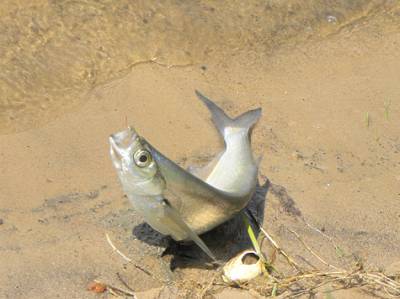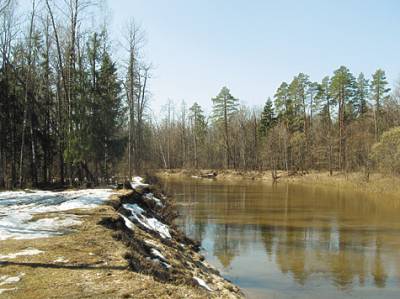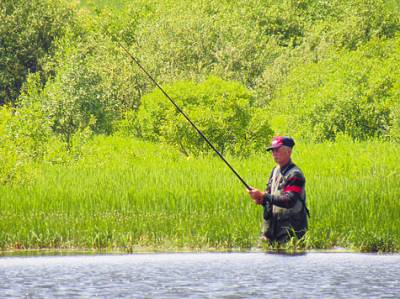
Similar to the sword chehon rarely becomes the prey of the angler-poplavochnye, especially on the waters of the Middle band, where the fish just a little, in contrast to the southern regions. But here, there are seasons when chehon suddenly appears in considerable numbers even in reservoirs of the Volga cascade, not to mention the Oka river and its major tributaries. Then chehon successfully and especially to catch bait, using dead or moving long-range snap-in.
Lifestyle, sabrefish biased toward large water bodies with a medium or moderate current, where the whole fattening period. Yes, and the spawning of this fish is not near the shore, as many cyprinid fish and in water, on spring stormy shoals of large rivers or in boiling flows spillways of dams. Then the fertilized eggs drifting downstream, it begins to slow down the pack spawned and actively feeding fish, and among the schools there is a clear age divide.
Periods best catching sabrefish sports gear is entirely dependent on the biological rhythms of her life. The first occurs in spring, when the fish mass movement to spawn is starting under a relatively strong ice. And here she is caught in winter.
Following a period of good catches sabrefish occurs after spawning. At this time South of the river are already included in the low water. Because flying insects — a favorite forage of small and medium-sized cahana is still small, the fish at the time poslenebesnogo Jora actively feeds on small molluscs, larvae of insects, which begins the spring emergence, and aquatic insects. As the warm water in the upper atmosphere, at the surface and above it there is a lot of feed, sabrefish is beginning to emerge from the middle depths and its behavior is more like habits of the typical horse fish.
This hungry enough for yourself time sabrefish becomes very responsive to the bait and can be easily caught sport fishing — float rod with a dull snap and float tackle for long casting.
For successful fishing first method, it is important to know where sabrefish may be closest to the shore: tired of spawning, it is the beginning of the summer fills the upper layers of the vast suwada around the headlands, Islands and shoals. You can also “settle” a lot of poop, which carry the main stream of the river. However, quite close to the shore chehon won’t fit, so the optimal length of the rods to a dull snap when catching sabrefish — 7-11 meters.
The main element snap — float — should be intermediate (2-5 g) have enhanced stability when fishing in shallow water and fast current, as the fish reacts very well to strong and long-lasting inhibition on the translation snap with jet on jet, as well as the transaction with the dip. All these manipulations you can perform with floats, having a delicate top, short, sharply flaring body and a massive long keel stainless steel wire in diameter 0.5-0.8 mm and a length of 100-150 mm. When fishing with a constant deceleration on the strong vortex flow, the float is better to slightly overload to with the manipulation of the tackle he might have got out of the water and well recorded even a weak bite.
If the wiring is used simultaneously with immersion, immediately after casting the stinging snap when all elements on the water fall strictly along a straight line, the angler begins evenly and fairly active (consistent with the power flow) to pull the tackle itself — across or against the current. In this case, the time during which ogruzka and the hook reaches the lower set point to tackle the descent, artificially increases.
This technique is very effective at catching of almost all trolling rod fish (bleak, sabrefish, Chub, Rudd), as well as fish that can take the nozzle throughout the water column, from surface to bottom (roach, Shemaiah, IDE, Dace). For such equipment fishing ogruzka snap is distributed almost uniformly throughout the length of the fixed slope, maybe with some offset from the float to reduce the number of tie-ins when casting.
Lure sabrefish, holding at the middle and strong currents in the water column, as well as bleak, with the only difference that the viscosity and composition of the mixture to a greater extent depends on the strength of the flow, and the depth of fishing and distance casting. Bait here, too, is built from the ingredients, giving much attracting the dregs — milk powder, egg powder and freeze-dried animal blood; do not be redundant and flavors. All this is mixed with a “skeleton” — breadcrumbs, oatmeal and bran.
One of the leading roles in the bait for the fishing conditions will play a inert ballast — dry, pulverized clay, river sand or fine gravel. They have a disintegrating action, and most importantly, significantly increase the weight of the prepared composition, which allows you to throw the ball where necessary bait and on an unstable vortex flow to focus the impact of bait at your chosen location. Feeding the bait to a strong current it is necessary quite often, as it is intensively removed from areas of fishing, but the size of servings will depend on the activity of fish and partly of depth.
But here comes the so-called years of confusion, when chehon was not going in huge shoals, sufficiently fed and fed almost the entire area of habitat. It ends when enough older fish fry new generation will come to regulatsia the open water. This usually occurs in July-August. In the southern rivers from that moment almost all the fish, including chehon goes to food as fingerlings — are very numerous, accessible and high-calorie food. Since that time, when huge flocks of sabrefish begin to pursue and countless schools of fish trivia starts autumn period of her active and productive fishing.
Feeding chehon easily detected by the cloud of gulls, always accompanying the “massacre”, and the characteristic bursts when several hundred fish wheel turned on a water surface. This behavior sabrefish due to the fact that her upper mouth and it is difficult to capture their prey in the water column, ugoku. So fish collectively “squeeze” the fry to the surface and grab them as insects that have fallen into the water.
Pack sabrefish rarely approach the shore, preferring to wield considerable remove from it, this means that successful fishing will require a boat, mounted at anchor near feeding fish or slowly drifting along with it with the current or wind.
Chehon — this is the catch that is hard to keep fresh in the hot summer, because even planted in the spacious mesh cage, it quickly becomes clogged over, weakens and falls asleep. Therefore, the sleeping fish, it is better to send in the brine or salt in the dry way, the more that sabrefish for this is mainly intended — she possesses excellent delicate flavor.
DURING JORA
In spite of the quite certain food cravings sabrefish shown at this time, it is easy to seduce her. Float snap with large maggots on the hook, planted in the midst of being caught in the excitement of the fish, will have to immediately withdraw from the water along with violently resisting, but it shouldn’t cause too much trouble prey. If chehon bite large, then it is better to bring the boat under water and smoothly accelerated to throw in the hand. With smaller fish you don’t have to stand on ceremony, especially as sabrefish is durable enough lips. It is clear that the bait for fishing among feeding flocks will be a luxury. It will be needed only in the case when a flock of sabrefish will quickly get away from boats or fail to locate actively feeding school.







